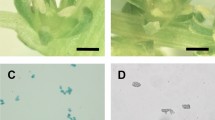Summary
Development of anthers in cytoplasmic male sterile (CMS) Petunia diverges from the normal sequence of events early in meiosis. Quantitative and qualitative changes in morphology, proteins and free amino acid contents correlate with this divergence. In anthers of the fertile line (5719), total protein content increases, and SDS-PAGE protein patterns change as the anthers mature. Enhanced levels of three polypeptides with molecular weights of 64,000, 63,000 and 45,000 daltons characterize premeiosis in fertile anthers. Protein levels and patterns from anthers of the CMS line (5707) show little alteration during anther development. Protein synthesis seems to be at least partially blocked in the CMS microspore. The 63,000 and 45,000 dalton proteins are not present, and the absence of any unique protein(s) in the CMS line argues against a virus as the causal agent of CMS in Petunia. Analysis of free amino acids from anthers of the fertile line shows levels of proline and pipecolic acid 2–3 and 10–20 fold higher, respectively, than in the CMS line. The amino acids incorporated into proteins show no such differences; analysis of protein hydrolysates shows similar levels of each amino acid in both fertile and CMS lines at every developmental stage examined.
Similar content being viewed by others
References
Dungey NO, Davis DD (1982) Protein turnover in isolated barley leaf segments and the effect of stress. J Exp Bot 33:12–20
Edwardson JR (1970) Cytoplasmic male sterility. Bot Rev 36: 341–420
Edwardson JR, Corbett MK (1961) Asexual transmission of cytoplasmic male sterility. Proc Natl Acad Sci USA 47: 390–396
Frankel R, Izhar S, Nitsan J (1969) Timing of callase activity and cytoplasmic male sterility in Petunia. Biochem Genet 3:451–455
Gerstel GU (1980) Cytoplasmic male sterility in Nicotiana (a review). NC Agric Res Serv Tech Bull 263:1–31
Laemmli UK (1970) Cleavage of structural proteins during the assembly of the head of bacteriophage T4. Nature 227: 680–685
Laser KD, Lersten NR (1972) Anatomy and cytology of microsporogenesis in cytoplasmic male sterile angiosperms. Bot Rev 38:425–454
Lowry OH, Rosebrough NJ, Farr AL, Randall RJ (1951) Protein measurement with the Folin phenol reagent. J Biol Chem 193:265–275
McLellan T, Ames GFL, Nikaido K (1983) Genetic variation in proteins: comparison of one-dimensional and twodimensional gel electrophoresis. Genetics 104:381–390
Nakashima H (1978) Physiological and morphological studies on the cytoplasmic male sterility of some crops. J Fac Agric Hokkaido Univ 59:17–58
Palfi G, Pinter L, Palfi Z (1981) The proline content and fertility of the pollen of inbred maize lines. Acta Bot Acad Sci Hung 27:179–187
Pearson OH (1981) Nature and mechanisms of cytoplasmic male sterility in plants (a review). Hortic Sci 16:482–487
Rhodes D, Myers AC, Jamieson G (1981) Gas chromatography-mass spectrometry of N-heptafluorobutyl esters of amino acids in the analysis of the kinetics of (15N)Hx + assimilation in Lemna minor L. Plant Physiol 68:1197–1205
Stanley RG, Linskens HF (1974) Pollen biology, biochemistry, and management. Springer, Berlin Heidelberg New York, pp 154–163
Stewart GR, Lahrer F (1980) Accumulation of amino acids and related compounds in relation to environmental stress. In: Miflin BJ (ed) The biochemistry of plants, amino acids and their derivations. Academic Press, New York, pp 609–635
Tupy J (1963) Free amino acids in apple pollen from the point of view of its fertility. Biol Plant (Praha) 5:154–160
Wu FS, Lucas-Lenard JM (1980) Inhibition of ribonucleic acid accumulation in mouse L cells infected with vesicular stomatitis virus requires viral ribonucleic acid transcription. Biochemistry 19:804–810
Wu FS, Wang M-Y (1984) Extraction of proteins for SDS polyacrylamide gel electrophoresis from protease rich plant tissues. Anal Biochem 139:100–103
Zhang HQ, Croes AF (1983) Proline metabolism in pollen: degradation of proline during germination and early tube growth. Planta 159:46–49
Zhang HQ, Croes AF, Linskens HF (1982) Protein synthesis in germinating pollen of Petunia: role of proline. Planta 154:199–203
Author information
Authors and Affiliations
Additional information
Communicated by H. F. Linskens
Rights and permissions
About this article
Cite this article
Wu, F.S., Murry, L.E. Changes in protein and amino acid content during anther development in fertile and cytoplasmic male sterile Petunia . Theoret. Appl. Genetics 71, 68–73 (1985). https://doi.org/10.1007/BF00278256
Accepted:
Issue Date:
DOI: https://doi.org/10.1007/BF00278256




